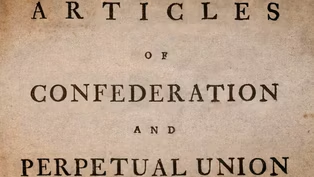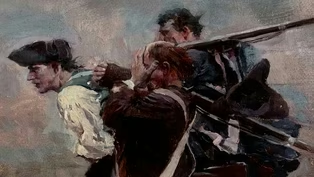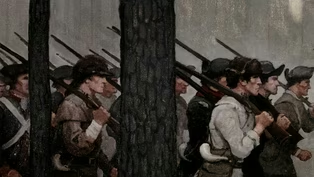
The Battle of Saratoga Begins
Clip: Episode 4 | 6m 18sVideo has Closed Captions
General Horatio Gates' force clashes with the British, beginning the Battle of Saratoga.
General Horatio Gates and his Patriot forces are dug in along the Bemis Heights just south of Saratoga, and the British Army led by General John Burgoyne. Burgoyne is determined to find the Patriots and drive them out. Some of his forces battle with Patriots led by Benedict Arnold and Daniel Morgan. The battle is a draw, but crucially, the British do not discover the main Patriot fortifications.
Problems playing video? | Closed Captioning Feedback
Problems playing video? | Closed Captioning Feedback
Episodes presented in 4K UHD on supported devices. Corporate funding for THE AMERICAN REVOLUTION was provided by Bank of America. Major funding was provided by The Better Angels Society and...

The Battle of Saratoga Begins
Clip: Episode 4 | 6m 18sVideo has Closed Captions
General Horatio Gates and his Patriot forces are dug in along the Bemis Heights just south of Saratoga, and the British Army led by General John Burgoyne. Burgoyne is determined to find the Patriots and drive them out. Some of his forces battle with Patriots led by Benedict Arnold and Daniel Morgan. The battle is a draw, but crucially, the British do not discover the main Patriot fortifications.
Problems playing video? | Closed Captioning Feedback
How to Watch The American Revolution
The American Revolution is available to stream on pbs.org and the free PBS App, available on iPhone, Apple TV, Android TV, Android smartphones, Amazon Fire TV, Amazon Fire Tablet, Roku, Samsung Smart TV, and Vizio.
Providing Support for PBS.org
Learn Moreabout PBS online sponsorship[Waves breaking, ship's rigging creaking] Voice: I needed all my courage and tenderness to keep my resolution of following my husband.
Besides the perils of the sea, I was told that we would be exposed to be eaten by the savages, and that people in America lived upon horse flesh and cats.
Baroness Friederike Riedesel.
Narrator: When German General Friedrich Adolph Riedesel left Europe in 1776 to join General Burgoyne's northern campaign, he had left his pregnant wife and two small daughters at home.
But as soon as she could, after her third daughter was born, Baroness Riedesel crossed the Atlantic with all three girls.
In mid-August, she caught up with her husband and Burgoyne's army at Fort Edward.
Voice: In the beginning, all went well.
We cherished the sweet hope of a sure victory and of coming into the promised land.
And when on the passage across the Hudson, General Burgoyne exclaimed, "The English never lose ground," our spirits were greatly exhilarated.
[Baroness Riedesel] Narrator: On September 13, 1777, two days after Washington's defeat at the Battle of the Brandywine, General Burgoyne's army in New York began streaming across the Hudson near Saratoga on a bridge of boats covered with planks.
Officers and men, women, children, horses, cattle, wagons, field-pieces-- it took three days for it all to cross.
Waiting for them some 10 miles south of Saratoga were General Horatio Gates' 6,900 Continentals and 1,300 militia, dug in along Bemis Heights, a broad plateau anchored on the right by the Hudson River and sheltered on the left by craggy wooded bluffs.
Colonel Tadeusz Kosciuszko, a Polish volunteer for the Americans, had chosen the site and laid out brigade encampments, breastworks, and artillery emplacements all along the Heights for 3/4 of a mile.
Patriot cannon commanded the river road to Albany.
Officers had a clear view of the rough terrain across which the British would have to march-- deep ravines and dense woods, broken here and there by half-cleared farmers' fields.
Most of Burgoyne's Native scouts had left him by now, so while he knew the Americans were somewhere ahead of him, he had no way of knowing how many they were or precisely how they were positioned.
On September 19th, he resolved to find out and then try to drive through the rebel lines.
He divided his force into three columns.
Scottish General Simon Fraser, with nearly 3,000 troops, set out to pinpoint his enemy's flank, hoping to locate high ground from which to fire on the rebels.
2,200 soldiers under German General Riedesel approached along the river road.
Burgoyne himself led the middle column-- some 1,700 soldiers--to assault what he guessed was the center of the American lines.
Watching from Bemis Heights, General Gates was content to wait.
This was his first battlefield command, and he was a careful, cautious man.
Both Fraser's and Riedesel's columns stalled, but Burgoyne's men managed to make it through the forest to a clearing named Freeman's Farm, where General Benedict Arnold and Daniel Morgan's riflemen went out to engage them.
[Musket fire] Atkinson: General Burgoyne asks for reinforcements.
Riedesel, who's a very fine commander, immediately sends some reinforcements up from the river to hit the Americans in the American right flank.
And this successfully stops the American momentum.
This First Battle of Saratoga, the Battle of Freeman Farm, it's a draw, basically.
You can say that the British have been successful in that they have held onto the ground, but for the most part, it's inconclusive.
Narrator: Burgoyne had not located the main rebel positions on Bemis Heights, and had lost 591 men, nearly twice as many as the Patriots had lost, and, unlike General Gates, Burgoyne had no realistic prospect of replacing them.
♪ Voice: I was an eyewitness of the whole affair and shivered at every shot, for I could hear everything.
I saw a great number of wounded.
And what was still more harrowing, they even brought three of them into the house where I was.
[Baroness Riedesel] ♪ Woman: Imagine what a battlefield looks like after a battle.
It has a lot of bodies.
It has a lot of blood and gore.
And it was the job of women to go in and take care of those bodies, to clean them up, to identify them, if they could, to see over the burial of bodies.
Part of the work of war is dealing with death.
Voice: Although we repulsed them with loss, we ourselves were much weakened.
The bodies of the slain were scarcely covered with the clay.
And the only tribute of respect to fallen officers was to bury them by themselves, without throwing them in the common grave.
So destruction comes with rapid wings, and ruin rushes on like a whirlwind to sweep the best officers, and sometimes almost entire battalions, from their strongest foundations.
Roger Lamb.
Video has Closed Captions
Clip: Ep4 | 2m 14s | The Articles were weak by design and left Congress unable to pay soldiers in the Continental Army. (2m 14s)
The British Capture Philadelphia & The Battle of Germantown
Video has Closed Captions
Clip: Ep4 | 6m 29s | The British seize Philadelphia, but Washington plans to retake the city at the Battle of Germantown. (6m 29s)
The Haudenosaunee Choose Sides in the American Revolution
Video has Closed Captions
Clip: Ep4 | 8m 7s | The Six Nations of the Haudenosaunee choose opposing sides at the Battle of Oriskany. (8m 7s)
Video has Closed Captions
Clip: Ep4 | 1m 9s | Artistic renderings of the Revolution often include the flag, but little is known about its origins. (1m 9s)
Patriot Victory at the Battle of Saratoga
Video has Closed Captions
Clip: Ep4 | 8m 59s | After days of fighting at Saratoga, Benedict Arnold and Horatio Gates secure a Patriot victory. (8m 59s)
Preview: Conquer by a Drawn Game
Video has Closed Captions
Preview: Ep4 | 30s | Philadelphia falls, but the American victory at Saratoga allows France to enter the war. (30s)
The Real People Who Fought the American Revolution
Video has Closed Captions
Clip: Ep4 | 4m 31s | Washington uses bonuses and drafts to encourage Americans to join the Continental Army. (4m 31s)
Religion & the Revolutionaries
Video has Closed Captions
Clip: Ep4 | 2m 5s | Most revolutionaries were Protestants, but there were also Catholics, Jews, and Muslims. (2m 5s)
Providing Support for PBS.org
Learn Moreabout PBS online sponsorshipSupport for PBS provided by:
Episodes presented in 4K UHD on supported devices. Corporate funding for THE AMERICAN REVOLUTION was provided by Bank of America. Major funding was provided by The Better Angels Society and...
























